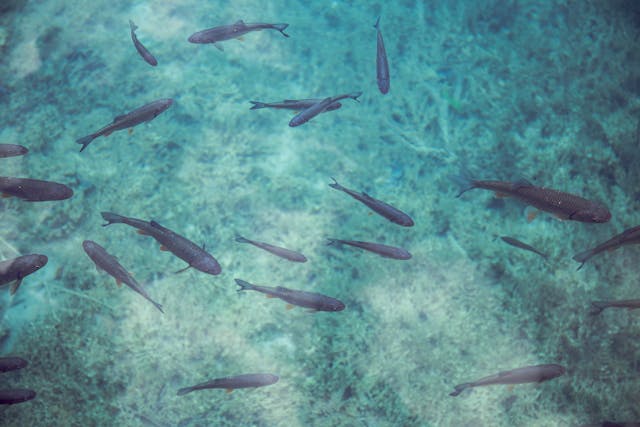In the vast expanse of the ocean, age holds profound significance in safeguarding marine life. A robust cohort of adult organisms is imperative for perpetuating generations in the underwater realm. However, despite the noble intentions behind their establishment, many marine protected areas (MPAs) need to fulfil their fundamental purpose: revitalising struggling fish populations. In a groundbreaking study unveiled on April 4 in Global Change Biology, researchers embarked on a pioneering quest to scrutinise the age composition of reef-dwelling fish within marine sanctuaries. Their findings were stark: across the board, the populations of adult fish within these havens either stagnated or dwindled.
Steve Canty, a marine ecologist affiliated with the Smithsonian Environmental Research Center and one of the study’s principal investigators, underscored the pivotal role of adult fish in marine ecosystems. He elucidated, “Adult fish play a pivotal role in multiple facets. They constitute the primary catch in commercial fisheries, thereby sustaining the livelihoods and nutritional needs of coastal communities. Moreover, it is the adults that foster reproduction and replenish fish stocks, wherein size assumes paramount importance. Larger and older female fish yield greater quantities of superior-quality eggs, thus emerging as linchpins in the restoration of fish populations.”
This revelation assumes heightened significance against the backdrop of the global race to achieve the “30 by 30” target, which aims to conserve 30% of the Earth’s oceans by 2030. Envisioned during the United Nations Biodiversity Conference in December 2022, this ambitious objective holds profound implications. However, its realisation hinges on the judicious selection of sites conducive to the flourishing of marine life while concurrently accommodating the needs of coastal communities.
The study, conducted in the realm of the Mesoamerican Reef, sheds light on this problem. Extending over 600 miles along the coasts of southern Mexico, Belize, Guatemala, and Honduras, the Mesoamerican Reef stands as the longest reef in the Western Hemisphere. Renowned as a biodiversity hotspot, this region harbours over 500 fish species and 60 varieties of corals and hosts one of the most extensive congregations of whale sharks on the planet. Moreover, the marine resources of this ecosystem underpin the sustenance and food security of over a million individuals.
Delving deeper, the researchers scrutinised the biomass of adult versus juvenile fish across 139 reef sites, comprising 111 protected and 28 unprotected areas. Within the Mesoamerican Reef, protected sites are categorised into three tiers: “fully protected areas,” where fishing activities are entirely prohibited; “highly protected areas,” permitting limited activities such as subsistence and catch-and-release sport fishing; and “general use zones,” where commercial fishing is often permitted albeit subject to restrictions on specific methods or equipment. Alarmingly, only a meagre 24% of the marine protected areas under scrutiny qualified as either fully or highly protected.
Melanie McField, co-author and director of the Healthy Reefs Initiative, lamented the intrinsic challenges associated with curtailing fishing activities. She remarked, “Prohibiting fishing in any marine domain poses a formidable challenge, seemingly conflicting with inherent human instincts. Nonetheless, the comprehensive protection and stringent enforcement of these areas represent the most efficacious strategy for nurturing larger fish populations capable of stimulating stock recoveries and augmenting overall fish yields beyond the confines of fully protected zones.”
Drawing upon data furnished by the Healthy Reefs Initiative, the research team meticulously analysed fish biomass trends spanning 12 years, from 2006 to 2018. Their findings painted a disturbing picture: despite their avowed objective of replenishing fish stocks, merely 8% of the surveyed sites witnessed significant upsurges in adult biomass. Conversely, the majority of sites exhibited no discernible alteration, with 28 sites reporting declines. A common thread among the declinatory sites was the prevalence of heavy coastal development in proximity, coupled with elevated sea surface temperatures. Notably, these sites predominantly fell within general use zones, characterised by lax enforcement and susceptibility to unabated exploitation.
Abel Valdivia, a marine conservation scientist affiliated with the World Wildlife Fund and co-author of the study, underscored the pernicious ramifications of minimal protection within weakly enforced MPAs. He elucidated, “Contrary to conventional wisdom, scant protection within feeble MPAs proves more deleterious than the absence of protection altogether. It engenders continued and concentrated exploitation sans efficacious oversight. Unlike open-access zones, where fishing pressure may be dispersed, inadequately protected areas succumb to unchecked coastal development, escalating sea temperatures, and deficient enforcement, thereby precipitating declines in adult biomass.”
However, amidst the bleak panorama, a glimmer of hope emanates from the 11 sites where adult fish populations experienced resurgences. Commonalities among these sites include their location within fully protected areas boasting robust enforcement measures, limited occurrences of sea surface temperature anomalies, and adjacency to regions characterised by a diminished human footprint.
This panoramic vista of the Mesoamerican Reef proffers invaluable insights into the global pursuit of the “30 by 30” conservation agenda. The cornerstone of MPA efficacy lies in the implementation of stringent enforcement mechanisms and prudent management practices bolstered by robust community engagement. Furthermore, the imperative of selecting sites cognisant of climate change emerges as a linchpin in this conservation endeavour. While certain oceanic domains may inevitably succumb to the ravages of warming waters, identifying sites capable of serving as climate refuges for both adult and juvenile life stages assumes paramount importance.
Justin Nowakowski, another lead author and ecologist affiliated with the Smithsonian Environmental Research Center, underscored the disparate responses exhibited by adult and juvenile fish to management interventions and environmental perturbations. He postulated, “Adult and juvenile fish evince disparate sensitivities to stressors such as climate change, thereby undermining the local efficacy of MPAs. The crux of the matter lies in identifying optimal sites for new MPAs to maximise positive outcomes for regional fisheries. This necessitates a nuanced understanding of the distinct requirements of adult and juvenile life stages, failing which, we risk overlooking the holistic picture.”
The study furnishes a clarion call to action, urging policymakers and stakeholders to recalibrate existing conservation paradigms. By prioritising robust enforcement, community participation, and climate-resilient site selection, the aspirations encapsulated within the “30 by 30” agenda may yet metamorphose into tangible realities, fostering the rejuvenation of our planet’s marine ecosystems.
More information: Steven W. J. Canty et al, Interplay of management and environmental drivers shifts size structure of reef fish communities, Global Change Biology. DOI: 10.1111/gcb.17257
Journal information: Global Change Biology Provided by Smithsonian








